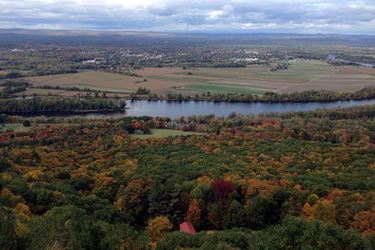EPA Researchers Develop Tool That Helps Water Quality Managers Meet Nutrient Load Targets
By U.S. EPA

Nutrient pollution is one of America’s most widespread, costly, and challenging environmental problems. This pollution can occur when excess amounts of nutrients, such as nitrogen and phosphorus, run off from land into streams, rivers, lakes, and other water sources. To help water quality managers reduce nutrient pollution, EPA researchers developed the River Basin Export Reduction Optimization Support Tool (RBEROST), a regional online tool currently available for the Upper Connecticut River Basin that provides low-cost solutions to meet nutrient load targets.
A nutrient load is the total amount of nutrients that enter a waterbody during a specific amount of time. Nutrient loads may come from different pollution sources, including point source and non-point source. Point source pollution is when pollution comes from a single, identifiable source, such as from sewage treatment plants. Non-point source pollution is when pollution does not originate from a single source and can come from a variety of sources, such as nutrient runoff from fertilizers into surface and groundwaters.
“Non-point sources of pollution such as agricultural and urban runoff are major sources of nitrogen and phosphorus loads to the Long Island Sound from the Upper Connecticut River Basin,” said EPA scientist Naomi Detenbeck, who is leading the project. “To prevent and control these sources of pollution, it’s important that water quality managers use best management practices.”
Best management practices aim to reduce the load of pollutants from land activities into waterways and assist water quality managers with meeting water quality goals. RBEROST offers various types of best management practices for reducing pollution from agricultural row crop land, urban land, wastewater treatment plants, and riparian buffers, and the tool considers the best ways to combine these best management practices across a region.
RBEROST considers best management practices including conservation tillage, contour farming, and sedimentation ponds, among others, for reducing nutrient runoff from agricultural row crop land. For reducing pollution from urban land, RBEROST measures best management practices like bioretention basins and infiltration trenches. RBEROST also measures how two types of riparian buffers — grassed buffers and forested buffers — help reduce pollution run-off from impervious surfaces. These buffers help filter pollutants from runoff and remove excess nutrients from groundwaters. Additionally, RBEROST uses information on how well low-cost retrofit upgrades made at wastewater treatment plants on the Upper Connecticut River reduce nutrient pollution.
The tool uses data on management practice efficiencies, costs, and baseline nutrient loadings to create an optimization model that helps users meet total nitrogen and total phosphorus loading targets in watersheds at the lowest financial cost.
“RBEROST employs a model that selects the best values from a selection of variables to meet a certain objective. For example, stakeholders can currently use the tool to minimize costs,” said Cathy Chamberlin, an EPA ORISE postdoctoral fellow working with Detenbeck.
Users can also consider other constraints and decision variables associated with attaining nutrient loading targets and can explore how those variables affect the cost of reducing nutrient pollution.
Historically, it has been difficult and expensive to meet nutrient loading targets in waterbodies that drain into large river basins. RBEROST equips water quality managers and stakeholders with the ability to estimate costs and the probability of successfully meeting nutrient loading targets.
To test the effectiveness of RBEROST, EPA scientists conducted a case study of the tool in the Upper Connecticut River Basin. The Basin is one of the largest waterbodies that drains into the Long Island Sound between the New York City region and the southern New England Coast. The location served as an ideal study site since the Basin is affected by increased nitrogen and phosphorus loads largely from non-point pollution sources. These increased nutrient concentrations have resulted in negative environmental and human health issues, such as harmful algal blooms and fish kills. By applying RBEROST to the Upper Connecticut River Basin, researchers were able to identify the lowest-cost plans over a 15-year period. These plans included both point source and non-point source nutrient management practices, with most costs associated with managing runoff from urban stormwater.
While data for RBEROST currently only applies to waterbodies in the Upper Connecticut River Basin, the model structure is applicable to the whole northeast. The project team is also working to expand data availability to the entire northeast region and other geographic areas. To expand geographic coverage of underlying datasets, EPA scientists have been collaborating with the U.S. Geological Survey (USGS) to pilot RBEROST in the Puget Sound area. Additionally, the scientists plan to pilot the tool in the Mississippi River Basin, and hope that RBEROST will eventually work for the entire United States.
RBEROST is publicly available in EPA’s GitHub online repository. While anyone can use RBEROST, users must have R and RStudio software installed to access the data and code files. Once those are installed, RBEROST will install RShiny through its setup segment, which will allow users to customize management practices and loading targets. RBEROST is also compatible with USGS’ Northeast Regional SPARROW model, which is used to estimate major sources and environmental factors that affect the supply, transport, and fate of contaminants in streams.
Learn more:
Nutrient Pollution Policy and Data
Basic Information about Nonpoint Source (NPS) Pollution
